Fungal diseases of concern in 2022 Queensland mungbean and soybean crops
Fungal diseases of concern in 2022 Queensland mungbean and soybean crops
Take home message
- Outbreaks of Fusarium wilt were reported in mungbean crops throughout southern and central Queensland in recent years. Avoid planting mungbean into paddocks with a history of Fusarium wilt. Practice Come Clean Go Clean strategies to minimise the spread of disease
- Field trials in 2022 revealed that the relative rankings of mungbean Fusarium wilt resistance is as follows; Onyx-AU (most tolerant) > Opal-AU > Jade-AU > Crystal (most susceptible)
- The PowderyMildewMBM app assists growers and advisors make fungicide application decisions to manage powdery mildew in mungbean
- Anthracnose, pod and stem blight and downy mildew were the most prevalent soybean diseases in Queensland crops in 2022. To avoid future infections, avoid planting into previously infected paddocks, sow disease-free seed, and rotate with non-hosts.
Overview of diseases in mungbean and soybean in 2022
Diseases remain a significant impediment to the achievement of maximum yield potential of grain legume crops grown throughout Queensland. A combination of poor host resistance, virulent pathogens, and ideal weather conditions will allow pathogens to infect crops and cause significant losses. A wetter than average season across southern Queensland resulted in the rise of several fungal root and foliar diseases in grain legume crops.
Annual disease surveys and diagnostic samples in 2022 indicated that the dominant mungbean diseases continue to cause significant constraints to the mungbean industry. Fusarium wilt and powdery mildew were the dominant diseases in mungbean crops throughout southern Queensland, whereas Tobacco Streak Virus remains the dominant disease in mungbean crops grown in central Queensland. In the 2021-22 summer season, the major diseases impacting soybean crops growing in Queensland included downy mildew, anthracnose, and pod and stem blight. A higher incidence of disease was reported in soybean crops growing in the Burdekin and Mackay regions.
Mungbean Fusarium wilt
Fusarium wilt and root rot, caused by Fusarium oxysporum and F. solani remains a significant threat to mungbean producers across the northern region. Yield losses attributable to Fusarium wilt have been estimated to be as high as 80% in affected paddocks, causing huge losses to individual growers and the mungbean industry. It is estimated that the disease caused somewhere in the vicinity of $4.8M losses during the 2020-21 season.
Plants may be infected at any stage of growth, however symptoms are more frequently seen on maturing plants after flowering. Plants infected early often wilt and die, whilst those plants that survive remain stunted. Leaves of affected plants turn yellow or brown and then wilt. The taproot of affected plants often rots. When the stem and root of affected plants is split open longitudinally there is a brown discolouration of the vascular tissues.
Fusarium wilt is more prevalent in heavy clay soils, particularly on the edge of crops and low-lying areas. Symptoms are more prevalent in crops experiencing stress, such as excess water or temperature extremes.
The species causing wilt will produce resistant spore structures (chlamydospores) that can survive in soils for many years. The pathogens can spread to unaffected paddocks with the movement of infected soil and crop debris attached to machinery and through the movement of irrigation and flood water. Successive plantings of mungbean will increase the population of the pathogens in the soil, making disease more likely in subsequent mungbean crops. Recent glasshouse studies revealed that the Fusarium pathogens infecting mungbean can survive in the roots of other hosts without causing disease, including sorghum, cotton, barley, soybean and chickpea. A recent glasshouse study also indicated that the disease may be more severe in the presence of root lesion nematodes, though further studies are needed to validate this.
Recent glasshouse studies indicated some varietal differences to the mungbean Fusarium pathogens. In glasshouse studies, both Crystal and Jade-AU were highly susceptible, whilst Onyx-AU was moderately resistant to both F. oxysporum and F. solani. The newly released cultivar, Opal-AU was not tested in glasshouse studies, though some anecdotal reports by growers and advisors during the 2021 cropping season indicated that Opal-AU had greater tolerance to the Fusarium pathogens than Jade-AU and Crystal.
Three GRDC/DAFQ-funded field trials were undertaken in 2022 to assess the susceptibility of mungbean varieties to Fusarium wilt. The field trials relied on natural infection and were conducted in paddocks with a history of mungbean Fusarium wilt. Trial locations were Cambooya and Kingsthorpe in southern Queensland, and Rolleston in central Queensland. The three trials each consisted of 32 plots made up of four varieties (Jade-AU, Crystal, Opal-AU and Onyx-AU) and eight replicates planted in a randomised block design. Each plot was 2m wide x 10m long with 4 rows per plot. Rows were planted 50cm apart with 250,000 plants per ha or approximately 12.5 plants per metre. The two field experiments in southern Queensland were planted on the 5th and 6th January 2022 for Kingsthorpe and Cambooya, respectively. The Rolleston field experiment was planted on the 2nd of March 2022. Initial establishment counts of seedlings were assessed in each field trial at approximately 20 days after sowing. Disease incidence was assessed 14 days later by counting the number of healthy plants in each plot. Disease incidence counts were made approximately every 14 days (or when accessible) until harvest. The Kingsthorpe site in southern Queensland was harvested on the 20th of April 2022. Unfortunately, flood and pest damage meant that the Cambooya and Rolleston sites were not able to be harvested.
Symptoms of Fusarium wilt were detected in plants at the Cambooya site as early as the second plant count, at 33 days after sowing. Figure 1 demonstrates the rate of disease development over time in the Cambooya trial, based on the percentage of healthy plants present in each plot. Note that the arrow in the figure indicates flowering for the different varieties, and there is a distinct increase in disease incidence from this point. The incidence of disease is higher in varieties with lower levels of resistance. For plant counts at the Cambooya site there was a significant interaction of cultivar x time (P<0.001). In particular, there was a significant interaction between the cultivars for the plant counts at flowering and the following three counts. The black gram cultivar, Onyx-AU, had a significantly lower incidence of Fusarium wilt from flowering onwards compared to the three mungbean cultivars. Opal-AU had significantly lower incidence of disease from flowering onwards compared to Crystal, and at the final plant count was also significantly different to Jade-AU. By the last plant count, in April 2022, Fusarium wilt had affected an average of 80% plants in each plot of Crystal, compared to only 22% in Onyx-AU. A comparison of final counts of healthy plants in the Cambooya trial found that the resistance rankings for each variety were as follows; Onyx-AU (most tolerant) > Opal-AU > Jade-AU > Crystal (most susceptible).
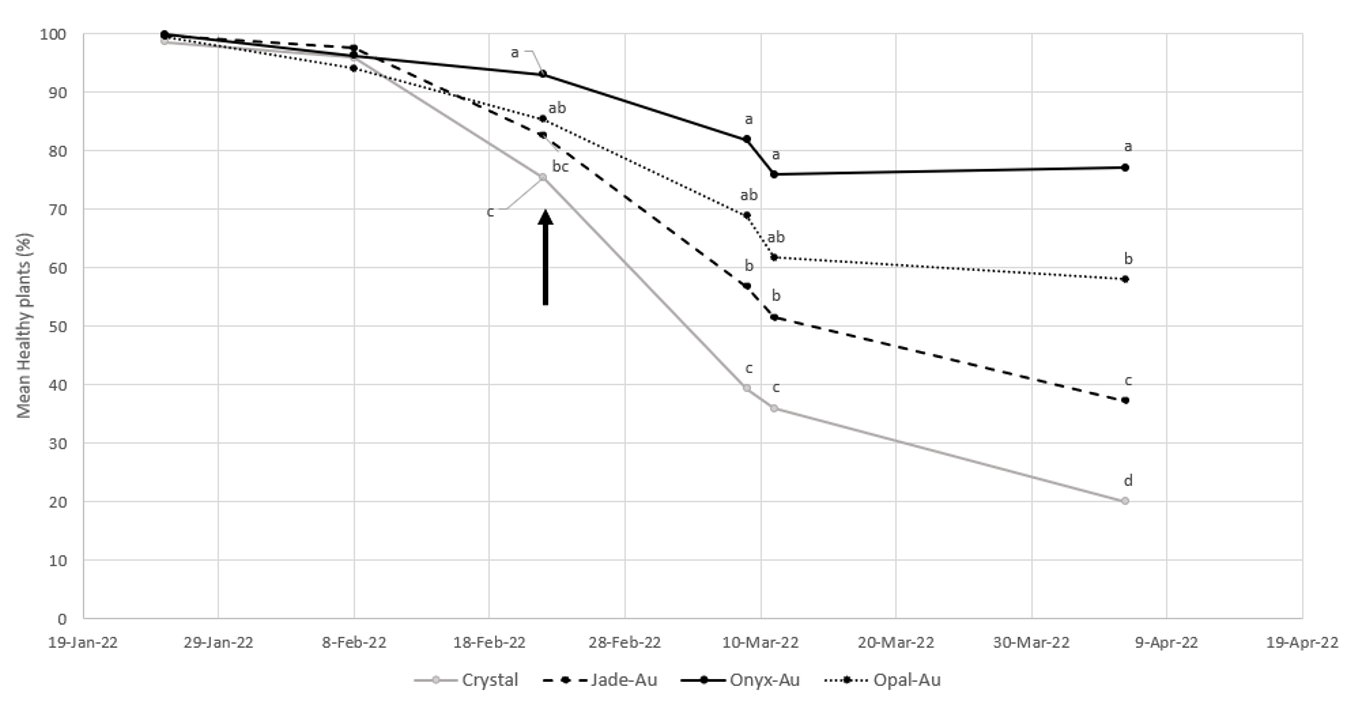
Figure 1. Mean percentage of healthy mungbean plants over time for each cultivar grown in the Fusarium trial at Cambooya in 2022. The proportion of healthy plants is reduced as the incidence of Fusarium wilt increases. The arrow indicates flowering. Significant differences for the mean healthy plants (%) between cultivars at the given date are designated a different letter (P<0.001).
A low incidence of Fusarium wilt was present in the trial at Kingsthorpe despite larger patches of Fusarium wilt affected plants in the mungbean crop surrounding the DAF trial. Despite low disease incidence, there was a significant interaction of date x cultivar for plant counts (P = 0.05). At the timing of the last plant counts in April 2022, an average of 97.8% of Crystal plants remained healthy compared to 105% of Onyx-AU (a value higher than 100% indicates that plants continued to establish themselves after the initial plant counts and therefore the final plant count was higher than the initial plant count). Disease levels remained low across the entire trial with most varieties establishing a higher number of plants than the initial counts by the end of the season. This trial demonstrates the patchiness of disease symptoms in an infected paddock. An analysis of grain yields collected from the Kingsthorpe site revealed a significant difference between varieties (refer to Figure 2). Jade-AU and Crystal yielded the poorest of the cultivars and yielded significantly lower than Opal-AU and Onyx-AU. Onyx-AU yields were significantly higher than the three mungbean cultivars.
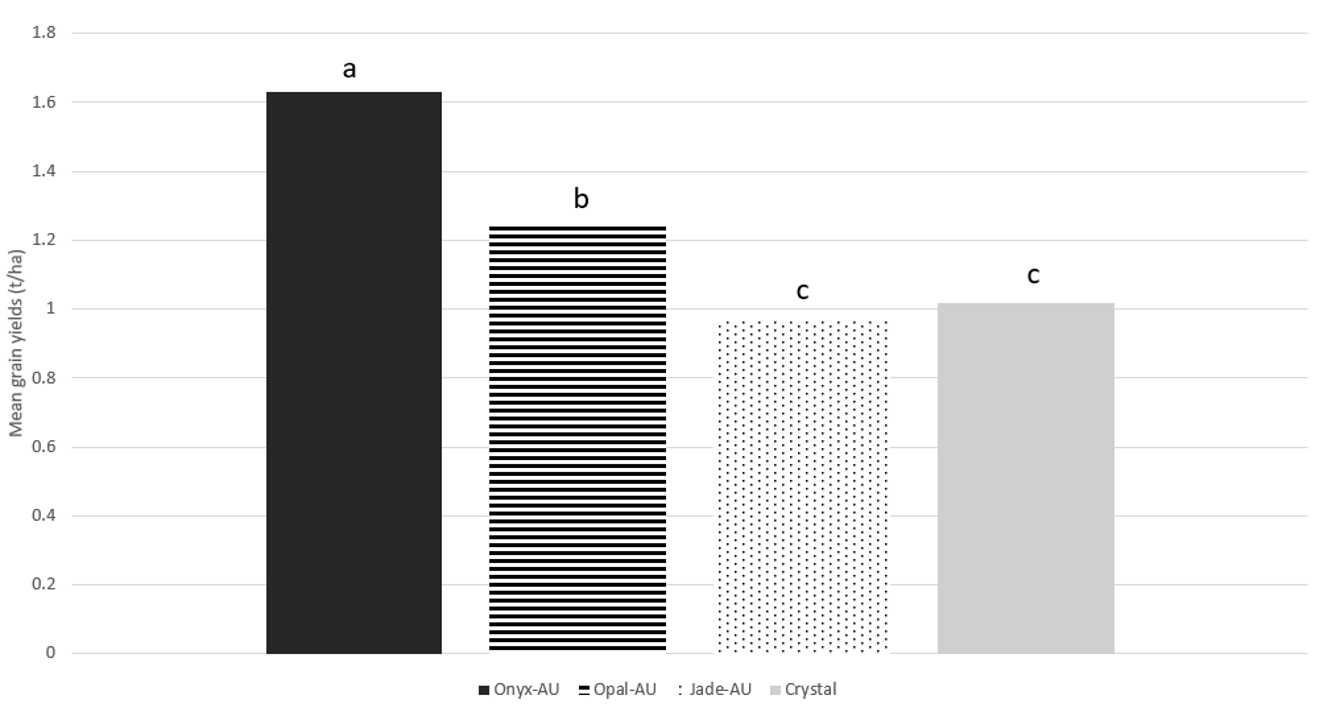
Figure 2. Mean grain yields of the four varieties grown at the Kingsthorpe site in 2022. Means with a different letter are significantly different at the P = 0.05 level.
A comparison of final counts of healthy plants in the Rolleston trial found that the resistance rankings for each cultivar were the same as Cambooya and were as follows; Onyx-AU (most tolerant) > Opal-AU > Jade-AU > Crystal (most susceptible). For plant counts measuring the percent of plants that were carrying disease in the Rolleston trial, there was a significant interaction between cultivar x time (P = 0.05). At the final plant count, Crystal had a significantly higher level of disease than Opal-AU and Onyx-AU. Jade-AU had a higher disease incidence than Opal-AU![]() and Onyx-AU
and Onyx-AU![]() but was not significantly different. Unfortunately, the trial was abandoned at the final plant count date (11th April), when plants were flowering due to pig damage to the trial. Disease symptoms at this point were becoming more obvious and it is likely that the difference between cultivars would have become more pronounced if the trial was able to continue until harvest.
but was not significantly different. Unfortunately, the trial was abandoned at the final plant count date (11th April), when plants were flowering due to pig damage to the trial. Disease symptoms at this point were becoming more obvious and it is likely that the difference between cultivars would have become more pronounced if the trial was able to continue until harvest.
The relative rankings of Fusarium wilt resistance for the four cultivars at Cambooya and Rolleston, based on the proportion of healthy plants, were similar to the rankings of grain yields at the Kingsthorpe site where Onyx-AU was the highest yielding followed by Opal-AU. Jade-AU was the lowest yielding at Kingsthorpe, however, was not significantly different to Crystal. These same rankings of disease incidence have been reported in the National Mungbean Improvement Program and match anecdotal reports from affected growers in 2021 and 2022.
The difference in disease incidence between the two sites in southern Queensland may have been due to the presence of root lesion nematodes in the Cambooya site (supporting the previous glasshouse studies). A high level of Pratylenchus thornei (23 nematodes/g soil) was detected in the Cambooya field site prior to planting the mungbean trial. More than 15 P. thornei nematodes/g soil is considered high and can result in yield loss. This additional stress may have exacerbated the severity of Fusarium wilt.
The risk of developing Fusarium wilt can be minimised by:
- Avoid planting mungbean in the same paddock for at least 3 years
- Avoid planting mungbean into paddocks with a history of Fusarium wilt
- Sow varieties with improved tolerance
- Manage the crop to avoid stresses such as root damage, root lesion nematodes, waterlogging and over-fertilisation
- Inspect the crop regularly for disease symptoms. Minimise or avoid movement through affected areas of the paddock. Visit healthy crops before visiting known infected paddocks
- Practise good farm hygiene and use the Come Clean Go Clean strategy to minimise the spread of disease
- Effectively manage volunteer mungbeans and weeds that may host the disease.
Mungbean powdery mildew
Powdery mildew impacts mungbean crops in Queensland every season. It was recently discovered that two species cause powdery mildew on mungbean in Queensland, Podosphaera xanthii and a newly described species, Erysiphe vignae. Both species can infect a single plant, producing the same symptoms. Symptoms are first evident on the lower leaves as small, circular, white powdery colonies. Powdery mildew colonies can quickly spread up the plant to cover the upper and lower surface of leaves. Powdery mildew can also cover the stems and pods of plants under severe infection. Infection may occur at any stage of plant growth when air-borne spores land on the leaf surface. Once the spore germinates, the fungus then sends feeding structures (haustoria) into the cells of the leaf (epidermis). Fungal strands (mycelium) grow across the leaf surface, resulting in a white, powdery growth. Spores develop from the fungal strands which become air-borne, spreading long distances in the wind. Disease development is thought to be favoured by cool (22-26ºC), dry weather, and under ideal conditions the cycle of infection may be as short as five days.
In conducive seasons, the disease can reduce yields in highly susceptible varieties by 40% when the pathogens infect the crop prior to flowering and are left unsprayed. The disease can also impact harvest by preventing defoliant sprays from working effectively. The variety, Opal-AU currently offers the best source of resistance to powdery mildew. Powdery mildew management heavily relies on the application of fungicides. Previous field trials have consistently demonstrated that powdery mildew in mungbean is best managed by applying a fungicide at the first sign of disease. Whether a second spray is required or not has been less clear. The fungicide options currently available for powdery mildew management are: tebuconazole products (430 g/L, 750 g/kg and 800 g/kg) (PER13979); Custodia® (and other registered products containing active ingredients tebuconazole 200 g/L plus azoxystrobin 120 g/L) (PER82104); and Veritas Opti® (containing active ingredients tebuconazole 370 g/L plus azoxystrobin 222 g/L). Over-reliance on these fungicides could lead to the development of fungicide resistance in mungbean powdery mildew populations.
The PowderyMildewMBM app, is a decision support tool (DST) released by GRDC in 2019 to help guide fungicide application decisions in mungbean. The PowderyMildewMBM app can be downloaded from the Apple or Google Play stores on iPads or tablets. The app was developed using disease incidence and severity data, weather data, and other parameters collected from replicated field trials in southern Queensland over several seasons. Users of the app input data (such as target yield, crop growth stage, spray costs and forecast weather conditions) to determine whether none, one or two fungicide applications are economical in the management of the disease. The app provides users an estimate of the minimum, maximum and most likely estimates of financial return to compare no spray, one or two fungicide sprays. Despite being released in 2019, the app has had limited uptake with industry, with many instances of fungicide application in combination with an insecticide spray whether powdery mildew is present or not.
In February 2022, a mungbean powdery mildew trial was sown at the University of Southern Queensland’s (USQ) Centre of Crop Health in Toowoomba to collect further data to validate the PowderyMildewMBM DST. The trial consisted of 24 plots of Jade-AU, each 6m long x 2m wide sown in a randomised block design made up of the six treatments listed in Table 1. In the trial, at the first sign of powdery mildew, initial fungicide treatments were applied on 10th April. Treatments requiring a second application (Treatments 3, 4 and 5) were applied on 30th April. Trials were rated using a 1-9 scale of disease incidence, where 1 = no disease and 9 = colonies of powdery mildew on the top leaves of every plant with leaf defoliation. Additionally, a 1-5 scale was used to assess the severity of the disease across the whole plot, where 1 = the plot was all green with only small colonies of powdery mildew visible, 5 = the plot was severely bronzed with leaf defoliation and colonies of powdery mildew covering entire leaves. The dry weight biomass (kg/ha) of each plot was assessed on the 2nd of June. Unfortunately, the trial could not be harvested for grain due to weather damage.
Table 1. Fungicide treatments included in the mungbean powdery mildew trial at USQ in 2022.
Treatment | Treatment details |
|---|---|
1 | One spray of tebuconazole at the first sign of disease |
2 | One spray of Veritas Opti® at the first sign of disease |
3 | Two sprays of tebuconazole, the first applied at the first sign of disease and then a second two weeks later, as recommended by the DST |
4 | Two sprays of Veritas Opti, the first applied at the first sign of disease and then a second two weeks later, as recommended by the DST |
5 | Two sprays of tebuconazole plus an insecticide (as per common industry practice) |
6 | No fungicide application |
Disease ratings were assessed on the 14th of April and 5th May, with data presented for the final rating in Figure 3a. At both assessments, there was severe powdery mildew infection covering more than 75% of the leaf area across the whole site. The incidence of powdery mildew was greatest in the no fungicide application (Treatment No. 6) at both times of assessment (Figure 1a and b). At the second time of assessment, two applications of Veritas Opti (treatment 4), had a significantly lower disease incidence compared to the other treatments, with colonies in the lower two-thirds of plants (Figure 3a). With the two applications of tebuconazole with insecticide (Treatment 5), the incidence increased slightly. All treatments except the single application of tebuconazole (Treatment 1) significantly lowered disease incidence compared to the untreated control.
On 2nd June, when plants were at the green pod stage, biomass was greatest after two applications of tebuconazole with insecticide (Treatment 5) but was not significantly different to the other fungicide treatments (Treatments 1, 2, 3 and 4) (Figure 3b). Biomass was lowest in the untreated control (Treatment No. 6) but was not significantly different to the treatment with one application of tebuconazole (Treatment 1).
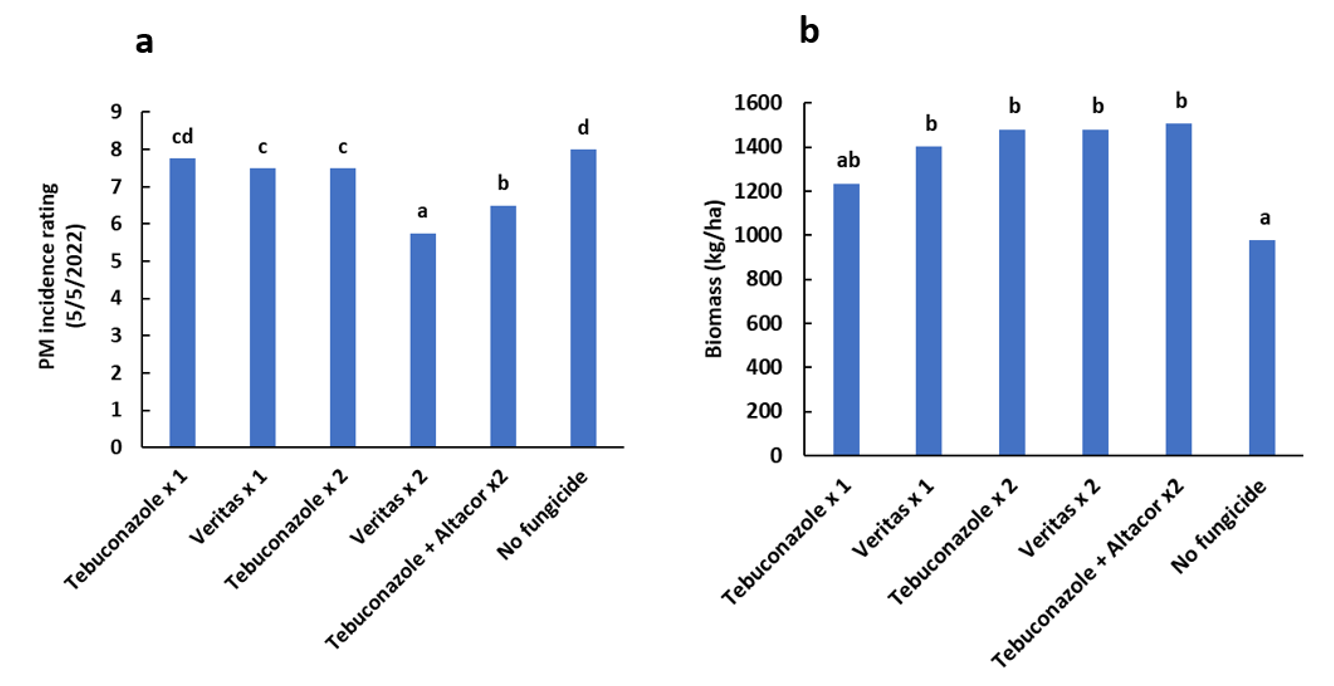
Figure 3. (a) Incidence of powdery mildew on 5th May 2022 and (b) biomass of Jade-AU (at green pod stage) for each of the fungicide treatments in the University of Southern Queensland, Toowoomba field site. Means with same subscript are not significantly different at the P = 0.05 level.
Three grower demonstration trials were also conducted in collaboration with agronomy groups on the Darling Downs to compare usual industry fungicide practices (such as applying fungicides in combination with an insecticide) to fungicides applied according to the app. Future validation and grower demonstration trials will be undertaken in the 2023 cropping season.
Soybean diseases in 2022
During the 2022 cropping season, thirteen soybean crops growing in Queensland were surveyed for disease and more than 200 separate soybean samples were submitted to the Queensland Department of Agriculture and Fisheries for disease diagnosis by growers and advisors. A lower incidence of disease was present in crops growing in southern Queensland, compared to those growing in the Burdekin and Mackay regions. The three major diseases in soybean crops in 2022 were anthracnose, pod and stem blight, and downy mildew.
Anthracnose, caused by Colletotrichum spp., was present in six crops surveyed in 2022 and confirmed in 116 diagnostic samples submitted for disease diagnosis by growers and advisors. Anthracnose has been an issue for soybean growers in Queensland in recent years, particularly in the Burdekin and Mackay regions where large outbreaks occurred in 2020. The pathogens that cause anthracnose in soybean are favoured by warm, wet weather, typical of those experienced in the Burdekin and Mackay regions. Anthracnose has not caused significant issues in southern Queensland, however, was detected at a low incidence in five crops in 2022.
The anthracnose pathogens can infect soybean at any stage of growth, though symptoms may only be expressed as plants mature. Foliar symptoms include browning of leaf veins, leaf rolling, petiole death and premature defoliation. Symptoms may develop on stems, petioles and pods as irregularly shaped, dark brown spots (Figure 4). Infected pods often produce fewer and smaller infected seed that may fail to germinate. In advanced stages, infected tissues are covered with black fruiting bodies (acervuli) with minute black spines (setae) (Figure 5b). Pre-emergence and post-emergence damping off may occur when planting infected seeds. The pathogen’s spores will spread in the wind and rain, or over long distances via infected seed. The pathogen will survive in infected crop residues and may be seedborne.
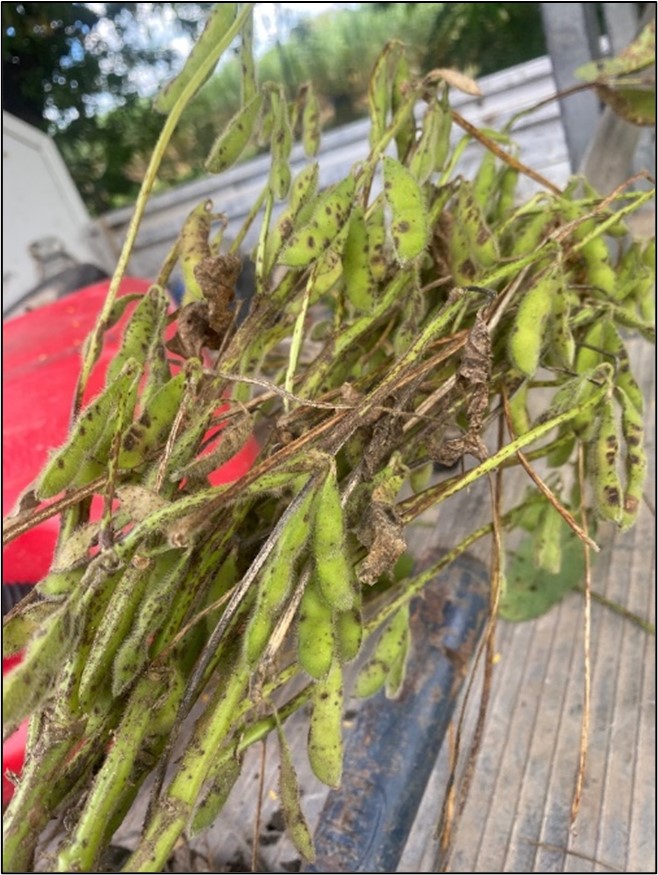
Figure 4. Pod and stem lesions on soybean plant infected with anthracnose.
Pod and stem blight, caused by Phomopsis and Diaporthe spp., was present in one crop surveyed and found in 12 diagnostic samples in 2022. Pod and stem blight can be present in green plant tissues without causing any disease symptoms. Petiole death and leaf yellowing may be seen in infected plants though symptoms are most obvious on pods and stems close to plant maturity when the fungal fruiting bodies become visible on infected plant tissues. Symptoms of pod and stem blight may be confused with anthracnose, however in the advanced disease stage a distinct difference is the presence of small black fruiting bodies arranged in rows on the infected tissues of a plant with pod and stem blight. Figure 5 displays the difference in advanced symptoms between pod and stem blight and anthracnose. Infected seed may be cracked, shrivelled, dull and mouldy. Wet, warm weather is conducive for disease development. The pathogens that cause pod and stem blight will survive in infected crop debris and seed and spread via rain-splash or wind.
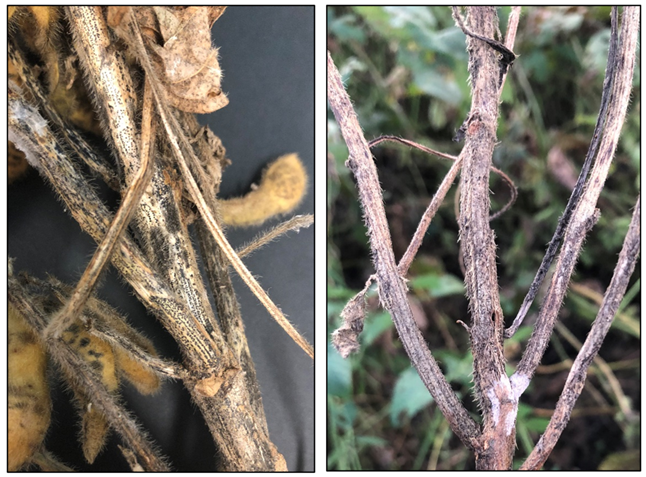
Figure 5. (a) Advanced symptoms of pod and stem blight (on left) with small black fungal fruiting bodies arranged in rows on the stem of an infected plant. (b) Plants with anthracnose (on right) have small black fungal fruiting bodies scattered randomly over the surface of infected stems.
The downy mildew pathogen, Peronospora manshurica, was detected in five soybean crops surveyed in southern Queensland in 2022. Though widespread in crops, the disease likely did not have a significant impact on grain yields. Plants can be infected with downy mildew at any crop stage with symptoms beginning as small light green to yellow spots on their upper leaf surface (Figure 6). The youngest leaves tend to be the most susceptible. A grey or tan coloured fungal growth often develops from the spots on the lower leaf surface during wet and humid conditions (Figure 6). Pods and seed can also become infected, where infected seeds tend to have a dull white appearance with a coating of fungal spores. Spores of the pathogen are spread by wind and rain. The pathogen can survive between soybean crops on infected leaves, on volunteer soybeans and alternative hosts and in soil and stubble. The pathogen can also be spread via infected seed.

Figure 6. Light green to yellow spots on the upper surface of a soybean leaf with symptoms of downy mildew. Tufts of tan or grey fungal growth develops on the lower leaf surface on the underside of the spots.
The risk of developing these three soybean diseases can be minimised by:
- Avoid planting soybean in the same paddock for at least 3 years or next to a previously infected paddock
- Rotate soybean with non-hosts, such as corn or grain sorghum
- Avoid sowing seed from affected crops
- Manage the crop to avoid stresses such as insect damage, waterlogging and over-fertilisation
- Use fungicides where appropriate
- Inspect the crop regularly for disease symptoms. Minimise or avoid movement through affected areas of the paddock.
- Practise good farm hygiene and use the Come Clean Go Clean strategy to minimise the spread of disease
- Effectively manage volunteer soybeans and weeds that may host the disease
- Consider agronomic practices that avoid producing a wet, humid environment (i.e. planting in wider rows or at a lower plant population).
Acknowledgements
The research undertaken as part of this project is made possible by the significant contributions of growers through both trial cooperation and the support of the GRDC and DAFQ, the author would like to thank them for their continued support. In particular, the authors would like to thank agronomists, Elizabeth Lobsey, Jeffrey Stone and Hugh-Reardon Smith, and mungbean growers for their contributions to the mungbean Fusarium and powdery mildew trials.
Contact details
Lisa Kelly
Queensland Department of Agriculture and Fisheries
Tor St, Toowoomba
Ph: 0477 747 040
Email: lisa.kelly@daf.qld.gov.au
![]() Varieties displaying this symbol beside them are protected under the Plant Breeders Rights Act 1994.
Varieties displaying this symbol beside them are protected under the Plant Breeders Rights Act 1994.
® Registered Trademark
GRDC Project Code: DAQ2106-007RTX, DAQ1806-003RTX, USQ2202-001RTX,
